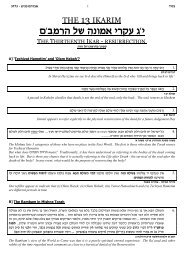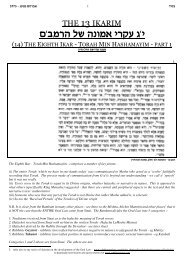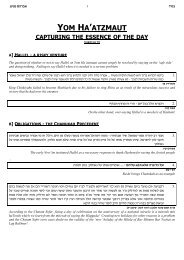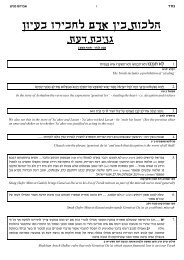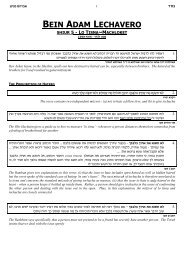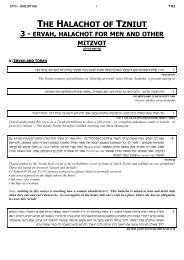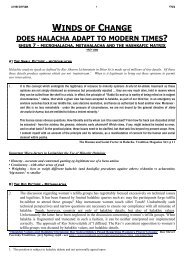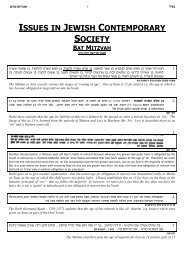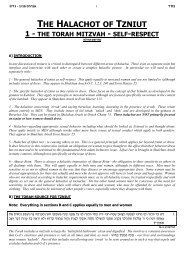Torah U'Madda - Rabbi Anthony Manning
Torah U'Madda - Rabbi Anthony Manning
Torah U'Madda - Rabbi Anthony Manning
- No tags were found...
You also want an ePaper? Increase the reach of your titles
YUMPU automatically turns print PDFs into web optimized ePapers that Google loves.
5773 - dbhbn ovrct1sxcISSUES IN JEWISH CONTEMPORARY SOCIETYTORAH AND SECULAR STUDIESPART 2: TORAH U’MADDAvhju kjr ,arsn rbhnxA] CHOCHMAT YEVANITic vns ic kta /// aunh tk ohhe - ,hcrgu ,hrja gna ,hre tkt ost tre tk whpt :hjuh ic a"r ouan ibjuh hcr rnt 1.:vzv trenv uhkg tre ?,hbuh ,nfj sunkk uvn 'vkuf vru,v kf h,snka hbt iudf :ktgnah wr ,t ktgnah wr ka u,ujt,nfj vc sunku vkhkv in tku ouhv in tk vbhta vga euscu tm 'vkhku onuh uc ,hdvu lhpn vzv vru,v rpx aunh tk/,hbuh:ym ,ujbnR. Yochanan said in the name of Rashbi: ‘Even if a person only reads the Shema in the morning and evening he has fulfilledthe mitzvah of (Yehoshua 1:8) ‘This <strong>Torah</strong> shall not leave [your mouths and you shall meditate in it day and night]’. Ben Dama, the nephewof R. Yishmael asked R. Yishmael: ‘For someone like me that knows the whole <strong>Torah</strong>, can I learn Greek wisdom?’ [R.Yishmael] replied with a verse: ‘This <strong>Torah</strong> shall not leave your mouths and you shall meditate in it day and night’. Go and find a timethat is neither day nor night and learn Greek wisdom!The response of R. Yishmael is unclear. He is effectively prohibiting the study of Chochmat Yevanit, but without sayingan outright ‘no!’vru, usnk ,utn anj 'tct ,hcc uhv ohskh ;kt /// d"car ouan ktuna rnt vsuvh cr rntvu ?trhxt hn ,hbuuh ,nfj 2.`uuv ,ufknk ihcures 'd"r ,hc ka hbta /// ,hbuuh ,nfj usnk ,utn anju:yn vyuxChazal understood that certain yeshivot were allowed to study ‘Chochmat Yevanit’ since they were involved with thegovernment and needed the knowledge of this chochmah to interact with the non-Jews,ufknk ohcure kg urzd tk vkhj,n - hnue rpxk urh,v 3./dp tne tcc ,upxu,Tosafot learn that this was not a special dispensation to the Yeshiva of Rabban Gamliel, but that Chazal never prohibited‘Chochmat Yevanit’ for people involved with the governmentuc ihrhfn ogv rta ihtu ihykp hbc uc ohrcsna vnfj iuak - ,hbuuh ,nfj 4.:yn vyux h"arRashi understands that Chochmat Yevanit is a type of clever language or jargon which the aristocracy spoke but theordinary people did not understandtk kct 'tcv okugvu vzv okugv vbeh vzcu 'ovhrjt ohfanbv ohexupvu trndu vban 'tren ot hf sunkk ostk ihtu 5.ohbhn hrpx uhvh tka sckcu ',unfj rtac htretc sunkk r,un n"nu /,unfj rta sunkcs ;hgx unr inhx vgs vruh lurg ijkua tnrHowever, a prohibition on learning ‘chochmat yevanit’ is not mentioned in the Shulchan Aruch. Furthermore, the Remaclearly rules in the Shulchan Aruch that the study of ‘other wisdoms’ is permitted on an ‘occasional basis’
5773 - dbhbn ovrct2sxcB] TORAH U’MADDA - A DEFINITIONkt ohudc vru, ah '(j t vhscug) uag rvn vbuc,u oustn ohnfj h,sctvu s"vv 'ihnt, ohudc vnfj ah ost lk rnth ot 6.(y:c vfht) vru, iht ohudc vhrau vfkn ch,fs 'ihnt,ohudc vhrau vfkn v"s c varp vcr vfhtChazal made a distinction between ‘Chochmah’ and ‘<strong>Torah</strong>’. Chochmah exists in the non-Jewish world; <strong>Torah</strong> does not7. the ideal on which the institution [YU] was based and which it exemplified - the “synthesis” of <strong>Torah</strong> learningand Western culture that goes by the name of <strong>Torah</strong> U’Madda, or the study of sacred Jewish texts along withthe secular wisdom of the world at large.<strong>Torah</strong> U’madda, <strong>Rabbi</strong> Dr Norman Lamm, Introduction - page xi8. [Tertulian] - “What has Athens to do with Jerusalem. What agreement is there between Academy andChurch?” For this Latin Church father, the gulf between them was unbridgeable. This assertion is of one piecewith his famous statement credo quia absurdum est, that he believed because it was absurd. Suchantirationalism never found a warm and hospitable reception among classical Jewish thinkers.ibid p59. <strong>Torah</strong> U’madda denotes the synergistic interrelation of religious study and secular or profane knowledge.ibid p610. <strong>Torah</strong>, faith, religious learning on one side and Madda, science, worldly knowledge on the other, together offerus a more over-arching and truer vision than either one set alone. Each set gives one view of the Creator as wellas of His creation, and the other a different perspective that may not agree at all with the first ... Each alone istrue, but only partially true; both together present the possibility of a larger truth, more in keeping with thenature of the subject of our concern. Yet, they are given from One Shepherd (Kohelet 12:11).ibid p23611. <strong>Torah</strong> U’madda is thus an effort, not at all unprecedented in the history of normative Judaism, to expand thearea of religious interest to include all of creation, and to bring ... humanity’s cultural creativity and cognitiveachievements within the parameters of <strong>Torah</strong>.ibid p12C] TORAH U’MADDA - HISTORICAL PRECEDENTS<strong>Rabbi</strong> Lamm brings three precedents in Jewish history where <strong>Torah</strong> and secular ‘chochmah’ have been put together in asystematic way. None of these reflects precisely what he has in mind for TuM but each presents a different model foranalysis
5773 - dbhbn ovrct3sxc(a) Model 1 - Maimonides and the academies of Medieval Spainuxbfb vgcrt urnta unf xsrp u,ut ihtrue ohbuatrv ohnfja ov uktv ,umn anjca ukt oherp vgcrt hbhbgu 12.rnut hbtu 'ihhruc kg ohrcsv kf dhavku gshk jf ivc vhv okuf tk uhv ohkusd ohnfju uhv ktrah hkusda p"gtu 'xsrpkrtan ovc tmuhfu r,unvu ruxtv gshk tuv racu ojku 'racu ojk uxhrf tkn,ba hn tkt xsrpc khhyk hutr ihta,uhuuv iye rcsu vcfrn vagn kusd rcs ohnfj urnt hrva ohnfj i,ut utre iye rcs ukt ohrcsa p"gtu ',umnvv"cev ghpava vkusdv vcuyv ova sugu 'vkj, ost ka u,gs ihcahhn iva 'inhsevk iv ihhutr f"pgt 'tcru hhcts/rme ck kgcu cjr ck kgc vatu aht kusdu iye kfv ogsha raptu 'tcv okugv hhj kujbk hsf vzv okugv cuahhkdh vfkv s erp vru,v hsuxh ,ufkv o"cnrThe Rambam’s first book of the Mishna <strong>Torah</strong> is ‘Sefer HaMada’ - the book of ‘knowledge’. In it he defines entry intothe ‘Pardes’ - the esoteric wisdom of ‘Ma’aseh Bereishit’ and ‘Ma’aseh Merkava’ - as essentially the study of physicsand metaphysics. These, he describes, as a ‘great matter’ compared with the ‘small matter’ of learning gemara etc!ostk ihtu /xsrpc kuhy ohnfjv ihc treb uvzu 'ohbhn hrpx uhvh tka sckcu ',unfj rtac htretc sunkk r,un n"nu 13.,umnv hbhsu r,hvu ruxht gshk tuvu 'ihhu rac uxhrf tkna rjtk er xsrpc khhyks ;hgx unr inhx vgs vruh lurg ijkua tnrThe Rema rules like the Rambam - that ‘other chochmot’ are part of the system of Pardes!ocnrv tku tuv tk xsrp ,t utr tk kct /// ocnrv hrcsn tuv 14.jh ,ut oa trdv ruthcThe Vilna Gaon rejects this totally - for him the Pardes represents the mystical system of kabbala'vbnn .uj okugca vn kf cuzghu hutrf shn, vc vdaha sg ost ka uckc ,raeb v"cev ,cvt ihta rurcu gush rcs 15.ygn ygn ot vcvtv vhv, vgsv hp kgu 'uvgsha ,gsc tkt v"cev cvut ubht 'lapb kfcu lcck kfc rntu vuma unfaha jf hpf ubue ,t uk ohghsunv ,ubuc,u ,unfjc khfavku ihcvk unmg sjhk ostv lhrm lfhpk 'vcrv vcrv otu/vru,v hsuxh ,ufkvc ubrtca unf dhavku ihcvk ostcu vfkv h erp vcua, ,ufkv o"cnrAt the end of the Sefer HaMada, the Rambam writes that the study of natural sciences is an essential part of developingproper Ahavat HashemHowever, the Rambam’s model of secular learning is limited to philosophy, natural sciences and metaphysics. It is notclear what the Rambam would say concerning the study of the humanities - literature, fine art etc(b) Model 2 - Rav Hirsch and <strong>Torah</strong> Im Derech EretzRav Hirsch, in mid-19C Germany, developed an educational system of <strong>Torah</strong> im Derech Eretz which involved the studyof ‘culture’ - science, history, literature, poetry etc. See Part 1 for an analysis of how Rav Hirsch saw the interplaybetween ‘Derech Eretz’ and <strong>Torah</strong>. R. Lamm sees Rav Hirsch’s approach as one of coexistence between <strong>Torah</strong> andDerech Eretz, rather than synthesis.(c) Model 3 - Rav Kook - Mystical Synergy16. “The sacred must be established on the foundations of the profane. The Chol is the the chomer for theKodesh and the Kodesh is the tzura for it. The stronger the secular, the more significant the sacred”Rav A.I. Kook - Orot Hakodesh 1:127A strong theme in Rav Kook’s philosophy is the notion that the holy is developed and strengthened by the underpinning ofthe ‘profane’ or, rather, the ‘not-yet-holy’. N.B. In general, many of Rav Kook’s followers have not accepted his views onthe raising of chol studies to a level of kodesh (see also Rav Kook’s inaugural address at the opening of HebrewUniversity).In practice the views of his son Rav Tzvi Yehudah do not focus as much on secular studies and the ‘chardal’ (charedi datileumi) view on secular studies has become much the same as the general charedi view - i.e. largely <strong>Torah</strong> Only
5773 - dbhbn ovrct4sxc17. Hirsch’s view of <strong>Torah</strong> and Wisdom is one of coexistence and therefore is essentially static. Kook’s is one ofinteraction and hence dynamic. Hirsch is an esthete who wants <strong>Torah</strong> and Derech Eretz to live in a neighborlyand non-combatant fashion for the cultural enhancement of both. Kook is an alchemist who wants the sacredto transmute the profane and recast it in its own image .... Hence for Kook TuM represents a genuine synthesis,with all the benefits and problems and dangers associated with that. For Hirsch, for whom the secular studiesare employed to order, define and assist the sacred and place it on a firm scientific basis - <strong>Torah</strong> im Derech Eretzis a relationship of coexistence. For Rav Kook, .... the motion goes in both directions. The less important one is.... the rationalization, explanation and adornment of the sacred by the profane. .... Far more significant is ....the radiation of kodesh towards chol, enobling it, raising it to the loftiest levels, sanctifying it, impregnating itwith meaning and purpose.<strong>Torah</strong> U’madda, pp 132-3D] TORAH U’MADDA - RABBI LAMM’S MODEL - NEO-CHASSIDUT18. The concept of avodah begashmiut is that G-d’s immanence in all creation, - in Nature as well as in <strong>Torah</strong> -means that the mundane, physical order represents a legitimate avenue of approach to G-d.ibid p17119. ... the Lurianic doctrine [is] that all existence is sustained by the holy sparks of divinity that are the vehicles ofDivine immanence. When one is involved in any worldly matter, he has it in his power by virtue of his thoughtsand intentions, to liberate those sparks, returning them to their Divine source. This act of the redemption orelevation of the Divine sparks is, in and of itself, an act of the greatest religious significance, not merely aninstrument for some later fulfillment. ... There is a very small step from avodah begashmiut to TuM, fromworship through corporeality to worship through intellectuality, from service of G-d with the body to service ofG-d with the mind .... The religiously inspired study of Madda is the cognitive equivalent of avodah begashmiut.... provided .... that it is pursued as an act of avodat Hashem, and not merely for career reasons, culturalcuriosity, or because it is socially expected.ibid p173-4<strong>Rabbi</strong> Lamm sees TuM as a new application of the one of the philosophies of Chassidut - that one is capable of raisingkedushah out of all mundane physicality in this world. So too, one can raise kedushah from the secular study of Madda,provided that one’s kavana is leshem shamayim. Note: in practice the Chassidim were amongst the greatest opponents ofsecular studies - R. Lamm is transferring a concept in chasidut to TuM20. The study of the sciences and humanities is, in effect, the study of Gemara and thus the fulfillment of the studyof <strong>Torah</strong>.ibid p165Note that R. Lamm’s ‘neo-chasidut’ model for TuM, whilst similar to that of Rav Kook, differs from it in a number ofimportant ways. First, Rav Kook develops more of an ontological and theoretical construct, whilst Chassidut is intendedto be a direct and practical mode of life. Secondly, whilst Rav Kook looks atomistically at the specific issue which isbeing raised to kedusha, ‘neo-chassidut’ looks holistically at the growth of the individual.E] TORAH U’MADDA - WHAT IT’S NOT!21. When we speak of <strong>Torah</strong> and Madda, it is not because of practical economic necessity or because we imputeany imperfection of inadequacy to <strong>Torah</strong> ... but because we affirm that both <strong>Torah</strong> and Nature are the results ofDivine revelation; and even as God is one, so there is no split between His self-revelation in <strong>Torah</strong> and Hisself-disclosure in Nature.ibid p144
5773 - dbhbn ovrct5sxc22. It should be made clear that when we propose the hasidic or Madda-as-worship model of TuM based on thistenet of avodah begashmiut, we rule out any equality between avodah begashmiut and a formal mitzvah, andbetween <strong>Torah</strong> and Madda .... The pursuit of Madda without <strong>Torah</strong> is devoid of any innate Jewish significance.Hence in addition to requiring that Madda be pursued “for the sake of heaven” and in the spirit of awe andreverence recommended by the Talmud for talmud <strong>Torah</strong>, the religious legitimacy of Madda would require thatone spend a significant proportion of his time in the formal study of <strong>Torah</strong>.ibid p177-823. To vulgarise this concept .... as an excuse to minimize the study of <strong>Torah</strong> or to deny its centrality, eithertheoretically or functionally, is to distort it most deplorably.ibid p177-824. Nature, the world, must not be neglected, and it must be studied and explored as part of man’s relationshipwith his Maker. But <strong>Torah</strong>, as more than a creation of God, but His very word, ever remains supreme.ibid p14725. For <strong>Torah</strong> U’Madda to be religiously meaningful, it is essential that <strong>Torah</strong> be acknowledged as possessingcentral value and primacy over all else. Only when such centrality is affirmed does the enterprise of Maddabecome pregnant with meaning and the promise of sanctity ... Indeed, only if one is firmly planted within, in theinner precincts of <strong>Torah</strong>, will he or she spiritually flourish in the outer courtyards of Madda as well.ibid p20226. The primacy of <strong>Torah</strong> must be a given in any viable TuM approach. This precludes any version of TuM thattreats <strong>Torah</strong> as a form of human culture only.... .ibid p22F] TORAH U’MADDA - THE DANGERSR. Lamm’s philosophy of TuM has been much criticized. Some criticism is based on misunderstanding of his positionse.g. some say he places equal weight on Madda as on <strong>Torah</strong>, or that he is satisfied with minimal <strong>Torah</strong> - which is clearlywrong (see above). However, other criticism is based on the suggestion that the learning of outside world is (andperhaps always was) just too ‘treif’ to bring it into our lives. R. Lamm accepts this as a danger and a risk but argues thatit is a risk that must be taken. The alternative is an isolationism which which cause more long-term damage27. As attractive and spiritually edifying as this doctrine of worship through corporeality is, its is quite dangeroustoo .... It is replete with antinomian possibilities; taken too far, it can undermine the halacha ...ibid p17528. Whenever there is an encounter of sacred and profane, there must be anxiety, for who knows but that insteadof the kodesh converting the chol, the chol will master the kodesh .... He who enters into this dialogue of <strong>Torah</strong>and Wisdom must tremble at the risks inherent in it, even while acknowledging that it is his duty to undertakeit. Many religious casualties have already resulted from this historic program of TuM and there are more yet tocome.ibid p134-5
5773 - dbhbn ovrct6sxc29. TuM holds that modernity is neither to be uncritically embraced, nor utterly shunned, nor relentlessly fought,but is to be critically engaged from a mature and responsible <strong>Torah</strong> vantage. It does not assume that all that isnew is good - or bad. It holds that the potential spiritual havoc wrought by confronting the insights and valuesof contemporary Western culture is far less pernicious to the truth of <strong>Torah</strong> than that caused by ignoring thewhole of man’s cultural heritage and thus not knowing how to deal with at all. .... Blinding oneself to a problemmay be psychologically more comfortable, less taxing and produce less tension, but it is a sure formula fordefeat and tension.ibid p54-530. One should not expose immature students to readings that will overwhelm them and rob them of their faith ...By the same token, one ought not to attempt to introduce 8 year olds to differential equations and thus poisonthem to the beauty of mathematics forever or immerse 10 year olds in the study of abnormal psychology andthus confuse them before they have had a chance to learn normal ways.ibid p206Of course, R. Lamm fully accepts that TuM does not accept uncritically all that modern society promotes as being ofvalue31. We must make it explicit and clear that we are committed to secular studies, including our willingness toembrace all the risks that this implies, not alone because of vocational or social reasons, but because weconsider that it is the will of G-d that there be a world in which the <strong>Torah</strong> be effective; that all wisdom issuesultimately from the wisdom of the Creator, and therefore it is the Almighty who legitimates all knowledge.Speech by R. Lamm to the OU convention (1967)It must be stressed that many at YU do not see TuM the same way as R. Lamm. Some see it more like Rav Hirsch’s <strong>Torah</strong>im Derech Eretz. Others see it as simply <strong>Torah</strong> and secular learning which is needed for parnasa or vocational training.One senior Rav at YU once defined the concept to the YU magazine, the Commentator, as "a yeshiva, mit [sic] a cafeteria,mit [sic] a college, in the same building". Dr. Karen Bacon, Dean of YU's undergraduate Stern College for women,defined <strong>Torah</strong> u-Madda as, "universal values and knowledge of the world seen through the prism of <strong>Torah</strong>."vc vkufs vc lupvu vc lupv rnut dc dc ic 32.cf vban v erp ,uctSome raise this mishna in Pirkei Avot and claim that it means that all wisdom is within <strong>Torah</strong>, so there is no need to turnto secular studies. Whilst the approach of the Vilna Gaon is to see secular chochmah as rooted in <strong>Torah</strong> (although R.Baruch of Shklov, encouraged by his Rav, the Vilna Gaon translated the geometry of Euclid into Hebrew!) this is not theapproach of all commentators. The Meiri on this mishna understands that it is simply informing us that all <strong>Torah</strong> issuescan be answered from within <strong>Torah</strong> - there is no need to turn to other disciplines for <strong>Torah</strong> answers. But, for example,one cannot learn physics or astronomy from <strong>Torah</strong>Others claim that learning Madda is bitul <strong>Torah</strong>. R. Lamm’s response is that the halacha is not like R. Yishmael whoallowed breaking from <strong>Torah</strong> only for the purposes of parnasa. The halacha is like Rashbi, that, whilst a person isrequired to know the whole <strong>Torah</strong>, a person can be yotzei the chiuv Talmud <strong>Torah</strong> with a minimal amount, day and night(see Part 1). The rest of a person’s time is a balance of TuM, in which <strong>Torah</strong> is the key and Madda is secondary but ofintrinsic religious value.Ultimately, the key criticism of TuM is not its inherent logic or beauty, nor its faithfulness to the sources or historicalprecedent, but rather whether it is a workable and practical philosophy for the average Modern Orthodox Jew who isnot necessarily an academic. If one is unable to integrate the academic value of Madda, is there any room for TuM?Are we then back to a philosophy which allows secular learning solely for the purposes of parnasa?




